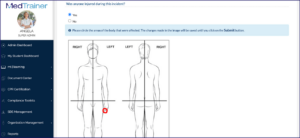In healthcare, safety and quality of care are paramount. Medical incident reports are tools that contribute to improving both patient care and workplace safety by shedding light on accidents and near misses, training gaps, and areas where practices may require adjustments. But to get the most out of these reports, healthcare professionals need to know how to write an incident report.
Well-written, comprehensive incident reports are critical, and an online incident reporting system can help streamline the process.
What Is an Incident Report in Healthcare?
An incident report is a document that outlines and details any unexpected or adverse events that occur within a healthcare facility. Incident reports are an important part of maintaining healthcare standards and regulatory compliance. Proper completion and storage of reports are crucial for audits and regulatory adherence, and records must be maintained for five years.
Beyond being a tool for internal assessment, these reports are mandated by organizations like the Occupational Safety and Health Administration (OSHA) to promptly report incidents causing death, serious injury, or hospitalization.
Steps To Write an Incident Report
Incident reports are, by nature, extremely detailed documents. Because their purpose is to not only record an incident but to help prevent future similar problems, they need to be well-written and descriptive. As a result, knowing how to write an incident report requires a systematic, comprehensive approach:
- Include basic information. Begin with the date of the report, the date and time of the incident, your name, job title, and contact information. Specify the location of the incident and indicate whether similar incidents have occurred before at the workplace.
- Describe what happened. Provide a clear, chronological account of the events leading up to the incident. Be specific and precise. For instance, if reporting a medication error, include details such as the brand name, manufacturer, and the exact nature of the error. Include the names, contact details, and identifying information of individuals involved.
- Describe the consequences. Outline the consequences of the incident, including any injuries or damages sustained. If applicable, describe the required treatment for injuries or any impact on the involved parties. If possible, include photographs or diagrams to visually depict the incident scene.

- Include documentation. Attach relevant evidence or documentation related to the incident. This could involve transcripts of conversations, audio recordings, or any other information that provides context and clarity.
- Explain corrective actions. Detail the actions taken in response to the incident. Specify who was involved and the timing of these actions. This may involve stabilizing patients, notifying supervisors, revising protocols, conducting training, or initiating a root cause analysis.
- Escalate the incident report. In most cases, incident reports require review by relevant personnel. Online incident reporting systems simplify this process, automating the escalation of reports to the appropriate individuals or departments.
Why Use an Online Incident Reporting System?
Healthcare is fast-paced and every moment counts where patient safety is concerned. Having an efficient incident reporting software is more than just a convenience — it’s a necessity. Traditional paper-based incident reporting methods have given way to online incident reporting systems, revolutionizing the way healthcare organizations handle incidents, near misses, and safety concerns.
Here’s why healthcare facilities are increasingly turning to online incident reporting systems to bolster safety, streamline processes, and enhance overall efficiency:
- Speed and accessibility. Online incident reporting systems offer a level of speed and accessibility that paper-based systems simply can’t match. With just a few clicks, healthcare professionals can submit incident reports from any location. This speed is crucial when it comes to reporting critical incidents promptly and ensuring that necessary actions are taken to prevent recurrence.
- Real-time escalation. Incident reporting often involves multiple layers of review and escalation. Online systems automate this process, ensuring that reports are promptly escalated to the appropriate individuals or departments. This eliminates delays caused by manual handovers and minimizes the chances of incidents slipping through the cracks.
- Customizable forms for precise data collection. Every incident is unique, and gathering specific data is essential for effective analysis and improvement. Online incident reporting systems allow organizations to create customizable incident reporting forms that capture the exact information needed for each incident type. This tailored approach enhances the accuracy of the collected data and empowers organizations to identify trends or patterns.
- Enhanced documentation and evidence attachment. In the digital landscape, attaching relevant evidence and documentation to medical incident reports becomes seamless. Conversations, images, audio recordings and other supporting materials can be attached directly to the report, to provide a comprehensive context that aids in understanding the incident — and formulating appropriate responses.
- Anonymity encourages transparency. Online systems often enable healthcare professionals to submit incident reports anonymously. This feature promotes a culture of transparency and encourages employees to report concerns without fear of repercussions. Anonymity fosters a safe environment for open communication about incidents and safety hazards, leading to better incident detection and resolution.
- Improved data analysis and trend identification. Data collected through incident reports is a goldmine of information that can drive improvements in patient safety and operational efficiency. Online incident reporting systems allow for systematic data analysis, and enable healthcare organizations to identify trends, patterns, and areas that require targeted interventions.
- Enhanced visibility for leadership. Leadership teams can benefit immensely from online incident reporting systems. These systems offer visual dashboards that present incident data in real time. This visibility empowers leaders to make informed decisions, allocate resources strategically, and monitor the effectiveness of interventions.
- Regulatory compliance is made easier. Healthcare organizations are subject to numerous regulatory requirements and reporting obligations. Online incident reporting systems streamline the process of compiling and submitting incident data to regulatory bodies. This ensures that compliance is met efficiently, to reduce administrative burdens and potential penalties.
Use MedTrainer for Your Medical Incident Reports
The value of safety, efficiency and continuous improvement can’t be overstated. Online incident reporting systems embody these principles, revolutionizing incident management, analysis, and prevention. By embracing technology, healthcare organizations can keep patients safe, support their staff, and elevate the overall quality of care.
With the right incident reporting system — like MedTrainer — your practice can create a culture of transparency, data-driven decision-making, and swift intervention. Learn more about MedTrainer’s incident reporting system today.
